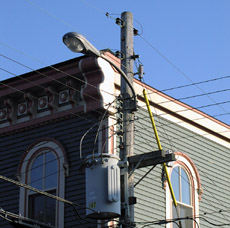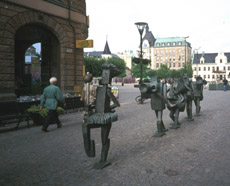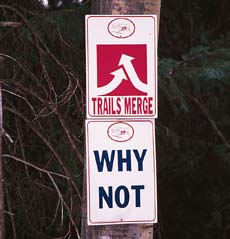Some hesitant suggestions

Connections

Optimist Orchestra street sculpture by Yngve Lundell, Malmö, Sweden

Why not make links and mergings?
The changes that would most profoundly affect the shape of suburban sprawl in America would be to alter governmental subsidies for highways, eliminate or limit tax deductions for mortgage interest, develop regional property tax systems that would lessen the competition among municipalities, reform school funding, and other large federal and state policies and practices that shape the incentives and options that guide development. Such changes are deep and difficult, and will be fought by entrenched interests. Various "smart growth" measures dealing with land use, density, and environmental issues show promise, though they are controversial and often watered down. A third set of strategies involve the New Urbanist and related development patterns. These have been enthusiastically accepted in some quarters, and may now make up 10% of new construction.
The book version of this study (Kolb 2008) discusses these issues in more detail than is done here. For still more thorough discussions, see Dreier 2001, Squires 2002 and Calthorpe 2004, which include ideas about large-scale policy changes that would dramatically alter the forces and incentives behind suburban sprawl and lead to higher densities.
But even if such reforms were successful, then aside from taxes and funding, the changes would affect mostly new construction. They would have gradual effects on already existing suburbs, as regionalization of taxes improved struggling inner suburbs, as public transit made new opportunities available, as occasional new constructions, replacements, and infill changed the densities and patterns in older suburbs.
Nonetheless the older suburbs where the majority of the U. S. population already lives would not be quickly effected. What can be done to stimulate awareness and self-reflection in already built suburbs, where no major new construction initiatives are occuring? I offer a few suggestions that might stimulate artists and designers to more effective ideas than these. These hesitant suggestions are meant to point up how inserts and add-ons might aid the goal of reducing the architectural self-sufficiency of sprawl houses and institutions. How do we remind people architecturally that they live in the network, not just in their local enclave? Without big budgets for construction, are there ways to make the experience of the suburb less familiar, more complex, to take away the apparent immediacy and inevitability of its patterns? Can we make more visible the processes (political, economic, cultural) that create and sustain suburban life? It may seem a paradox, but a sense of being in the wider network can strengthen our sense of unique locality, just as a better sense of how it fits into the ecology of a wider region can strengthen our loyalty to this particular valley.
Creating greater awareness of complexity within the already built suburbs is partly a task for artists, partly an issue for architects working on additions and infill, partly a need for planners and engineers to stop simplifying, partly a demand for new laws and economic policies, partly a matter of transportation and wiring. Sprawl presents the design challenge of turning already present large-scale clutter into more visible complexity and interrelation.
- Suggestions about planning for greater density
- Suggestions about style and architecture
- Suggestions for accentuatiing linkage
- Suggestions about awareness of ongoing processes
More complex inhabitation need not eliminate the sense of hominess and safety that many seek in the suburbs, but it should make them realistic. It should locate the senses of center and periphery, home and community, within the larger contexts and the flows of meaning and system that sway our lives. Those contexts and flows do not erase centers, but do keep them plural and interacting.
[Objection!]